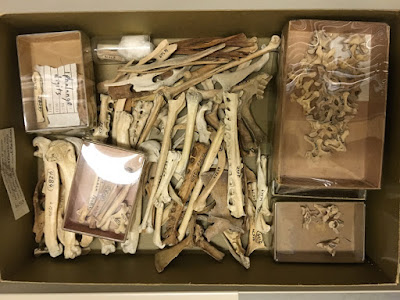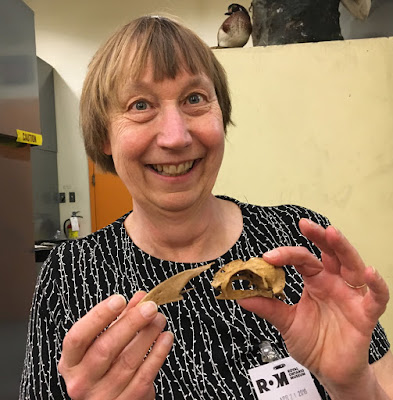by Jan Thornhill
 |
| "Museum" page from The Tragic Tale of the Great Auk (Jan Thornhill) |
While working on my new book about the extinction of the "northern penguin," The Tragic Tale of the Great Auk, I became aware that the Royal Ontario Museum (ROM) in Toronto was in possession of Canada's only stuffed one. Hoping to see it, I visited the ROM's brilliant Schad Gallery of Biodiversity, but was disappointed to find no Great Auk, though there was an equally extinct Labrador Duck on display. How sad, I thought, that the regal bird I sought was not on view, was instead tucked away in some dark cupboard, sealed, perhaps, inside a titanium box, safe, but invisible.
 |
| The extinct Labrador Duck (John James Audubon) |
But a couple of months later, when I arrived at the ROM to talk auks with Oliver Haddrath, the ornithology reasearch technician whose specialty is extinct flightless birds (like the poor Great Auk), I was thrilled to be led out into the same animal diversity gallery where this time—ta da!—behind two layers of glass, there it was, one of the last of the millions of Great Auks that once thrived in the North Atlantic.
 |
| Me and Canada's only Great Auk (Frankie Thornhill) |
There are only 78 stuffed Great Auks in the world, almost all held by museums. American museums own a decent chunk of them—eleven—though that number used to be twelve. The twelfth one was once owned by John James Audubon, the American bird painter famous for his Birds of North America book published as a double-elephant portfolio, "elephant" because it had to be big: Audubon presented all of his subjects life size. Though each page is a huge 39.5 inches tall and 28.5 inches wide, the largest birds—cranes, herons, flamingos—had to be doubled over in his compositions to fit.
 |
Because Audubon painted birds life-size, he had to double
over the biggest ones to make them fit on the pages. |
Audubon included the Great Auk in the book, but he never saw one alive. He had to base his painting on a taxidermy model, a specimen killed in Iceland in 1830 that he bought in London in 1836.
 |
| Audubon's Great Auks |
Eventually, Audubon gave has stuffed auk to a birder friend, Jacob Post Giraud Jr., who, in turn, gifted it (along with the rest of his large collection of stuffed birds) to Vassar College in 1867. There, "Audubon's Auk" gathered dust—quite literally—for more than 50 years, until it was found under a lab sink by Dr. L.C. Sanford who had connections to the American Museum of Natural History. Though the college continued to own the bird, Sanford convinced them in 1921 to allow him to send the auk off for renovation and remounting. When it was all spiffy again, it wasn't sent back to Vassar, but was housed instead at the Museum of Natural History in New York, hidden away in a double crate for the next 43 years.
 |
| The friendly face of the Royal Ontario Museum's Great Auk |
Though Canada had once been home to the largest Great Auk colony in the world—on Funk Island off the northeast coast of Newfoundland, (there had been no colonies on American soil at all)—by the early Sixties we still had no stuffed Great Auk of our own. The ROM was desperate to find one. Finally, they convinced Vassar to sell them Audubon's auk. In 1965 they paid $12,500 for it (the equivalent of about $100,000 today), and got a stuffed Labrador Duck thrown in for good measure—the same Labrador Duck I had seen on my earlier visit to the museum.
 |
| Signs on a door in the ROM's ornithology department (Frankie Thornhill) |
Oliver explained that, because bird feathers deteriorate more quickly when subjected to light, the museum only shows off its Great Auk for six months of the year. For the other six months, the Labrador Duck is the star.
 |
The ROM's Great Auk came from Eldey Island in Iceland,
the last place these birds nested after a volcanic eruption caused safer Geirfuglasker to sink beneath the waves. (Jan Thornhill) |
As thrilling as it was to finally see an actual Great Auk, I couldn't exactly get close to it, displayed, as it was, at a height and behind double panes of glass. But then Oliver led me and my sister, (who had the camera—yay!), into the secret storerooms of the bird department. First he showed us the egg room. The ROM has a lot of bird eggs. In fact, it has roughly 12,000 sets, a "set" being the number of eggs normally laid in a nest. There is a bird skin room, too, where thousands of boneless birds from around the world are laid out in drawers.
 |
| A tiny sample of the ROM's 11,715 bird egg collection (Frankie Thornhill) |
These collections are kind of shocking to see, since each skin and each egg represents a life cut short, but almost all were collected long before any of us was born, in an era when there were a) way more birds of all kinds, and b) different attitudes towards killing wildlife.
For a while there was a question about whether or not museums should waste precious space storing so many skins and eggs, especially when some species are represented by multiple specimens. The ROM's collection wasn't culled, which is fortunate because it has become clear that these lovingly stored remains hold a treasure trove of information that no one a hundred years ago could have imagined: DNA. When the DNA from skins of birds of the same species that were collected in different places, or ones collected from similar locations but years apart, is compared, we can learn a lot about how our world has changed, and how it continues to change.
 |
| Nine of the ROM's 136,350 study skins (Frankie Thornhill) |
Similarly, each egg in the collection has documentation of exactly when and where it was collected. These dates, sometimes from more than a hundred years ago, can be compared to the nesting dates of contemporary birds to help us learn how various species are adapting—or not adapting—to climate change.
 |
| Great Auk bones collected on Funk Island (Frankie Thornhill) |
Though the eggs and study skins were fascinating and often gorgeous, the pièce de résistance of the tour was yet to come. Without saying anything, Oliver opened a drawer and pulled out a small, nondescript cardboard box. He opened it. It was filled with bones. Great Auk bones. Auk bones that included a skull and upper beak. Which Oliver handed to me.
 |
| Me giddily holding an extinct Great Auk's skull and beak (Frankie Thornhill) |
Maybe that doesn't sound like a big deal. But it was. I'd just spent the better part of a year living with the Great Auk, reading about its amazing and tragic history, its connections to prehistoric and First Nations peoples on both sides of the Atlantic, learning about its anatomy, writing about it, drawing it, painting it, dreaming it. I was so familiar with it it had become my totem animal. And I was holding in my hands the head of one that more than two hundred years ago had swum the North Atlantic. Though you can't tell from the photograph, I was so excited my hands were shaking.
There's only one thing that could have been better. To see an actual, living Great Auk. But, of course, that would be impossible, since the Great Auk has been extinct since 1844. But,wait! Maybe in the future it won't be impossible. Stay tuned for my next post about efforts to resurrect the Great Auk!
I made Great Auk cookies for my book launch!
published by Groundwood Books















5 comments:
Great post, informative and lively. Thank you.
Wonderful to read how these museum visits affected you. Museums are treasure troves! It's fabulous to learn there.
Really interesting article! I've written and published a children's book about a juvenile Great Auk (the last of his kind) who is searching for more great auks (alas - he will never find one). In my second book - being written now, he travels to Canada to look for Great Auks there! The book is aimed at informing children about the Great Auk and will also hint at the dangers of extinction as my auk's sidekick is a puffin, a species that could face extinction in the future due to environmental issues and over-fishing!
It isn't Canada's only Great Auk.
There is a Great Auk on public display in St. John's, NL at the Rooms (https://www.therooms.ca). The Rooms is the Provincial governments consolidated primary archives and Museum. If memory serves there are other "non-display" great auk specimens preserved both at The Rooms and Memorial University.
The Rooms also has one of the first confirmed giant squids found intact preserved and on display.
In the 1930's, E. Thomas Gilliard, who was an ornithologist working at the New York Museum of Natural History, and a friend, set off for Newfoundland to gather bones of the Great Awk. The story of their trip is one of overcoming many obstacles and frightful weather, but they did come back with enough bones to reconstruct 2 Great Awks. one was sent to Canada and one was in The Museum.
Post a Comment